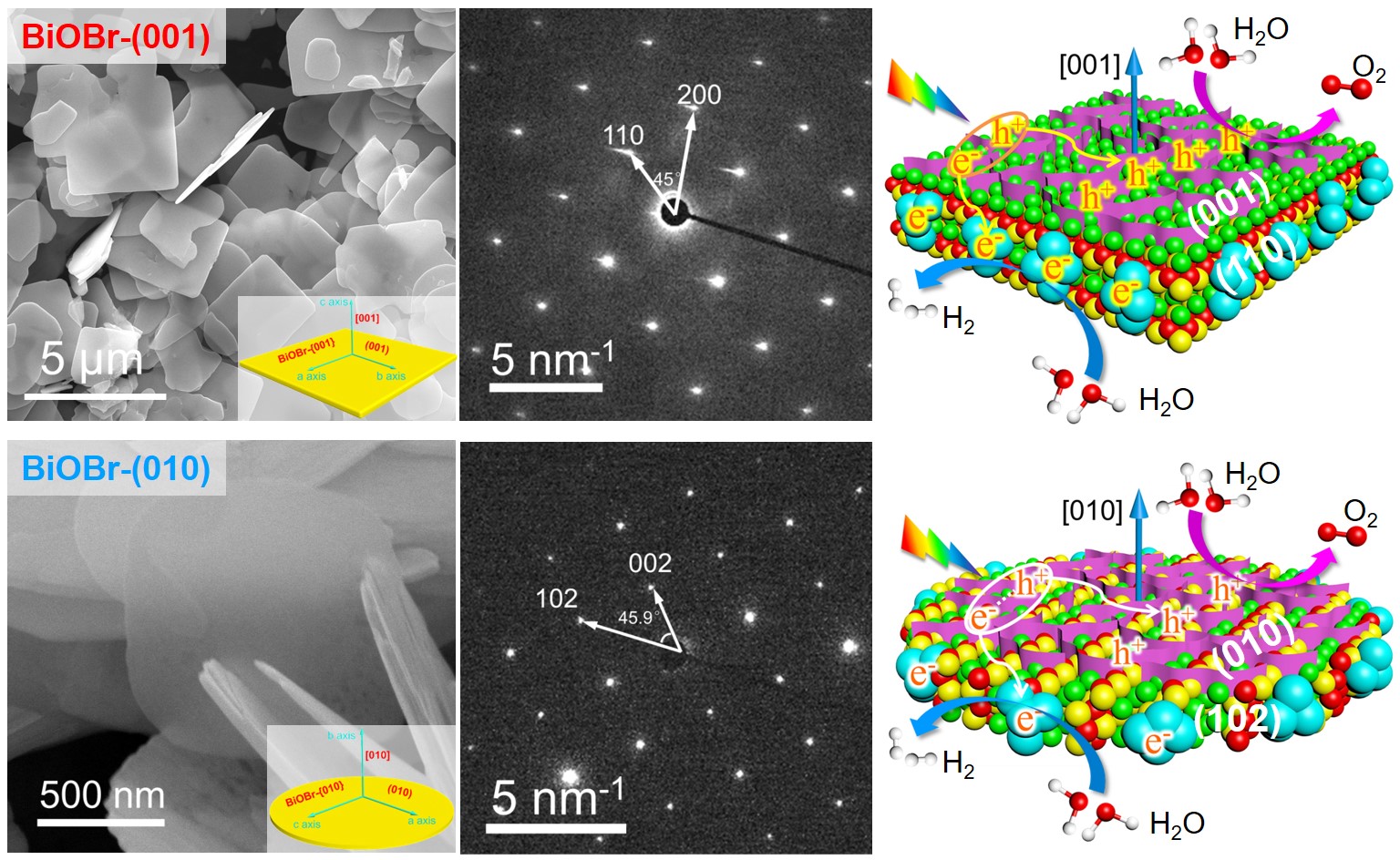Research groups led by Prof. Can Li and Prof. Rengui Li from the Dalian Institute of Chemical Physics (DICP) of the Chinese Academy of Sciences (CAS) achieved new advances in research on the essential role of exposing crystal facets in semiconductor photocatalysts. They unraveled that the photocatalytic activity of semiconductor photocatalysts is not directly correlated to the highly exposed facets, but intrinsically originated from the photogenerated charge separation properties between the highly exposed crystal facets and co-existing crystal facets.

Artificial photosynthesis for solar fuel is considered as a "Holy Grail" in scientific research, the core and bottleneck process of is the photogenerated charge separation, which is becoming a challenging topic in artificial photosynthesis. Prof. Can Li’s group has been dedicated to this cutting-edge issue for artificial photosynthetic solar fuels for ~20 years and achieved a series of significant progresses. They have proposed a novel phase-junction strategy for efficient charge separation (Angew. Chem. Int. Ed., 2008; Angew. Chem. Int. Ed., 2012), unraveled the spatial charge separation between different crystal faces (Nat. Commun. 2013;Energy Environ. Sci. 2014), designed a strategy for charge separation on high-symmetric semiconductor materials (Energy Environ. Sci. 2016), proposed a new strategy for constructing efficient artificial photosynthesis systems with intrinsic polarity of semiconductor materials (Angew. Chem. Int. Ed., 2020) and developed novel techniques to in-situ image the photogenerated charges (Angew. Chem. Int. Ed., 2015; Nat. Energy, 2018). These research progresses have been well recognized by the academic community in artificial photosynthesis. In particular, the spatial charge separation between different crystal facets of semiconductors has been becoming into an attractive and appealing topic in this field, which has been widely proven to be an effective strategy to boost the photocatalytic activity. Although many reports attribute the difference in photocatalytic activity to the high exposure of active crystal facets, some conclusions on the highly active crystal facets for photocatalytic reactions are often contradictory, which greatly hindered the understanding about the influence of crystal facet and morphology on the photocatalytic mechanism. In this work, based on the research of spatial charge separation between different facets, the researchers took the typical bismuth oxybromide (BiOBr) semiconductor as the model, and synthesized two types of BiOBr nanocrystals exposeing with representative (001) and (010) facets, respectively. It was found that the intrinsic photocatalytic activities of BiOBr is not directly owing to the highly exposed facets, but dominantly determined by the co-exposing facets although the proportion ratio of the co-exposing facets is not high. The co-existing crystal facet directly determines the oxidation and reduction properties of the highly exposed crystal facet in the photocatalytic reactions, providing the possibility to modulate the properties of different exposed facets for semiconductors, so that the spatial charge separation between the highly exposed crystal facet and co-exposing facets occurs effectively. It is the spatial charge separation between different facets that renders the reduction and oxidation reactions to separately occur onto the dominate facet and the co-exposing facet with different reaction rates, and the matching of oxidation and reduction reactions determines the intrinsic reactivity of BiOBr nanosheets. This work unravels the intrinsic facet-dependent photoreactivity of semiconductors and systematically elucidates the reason why the photocatalytic activity depends on crystal facet of semiconductors, which will shed light on the understanding the mechanisms of photocatalytic solar energy conversion systems. This work was recently published on Angew. Chem. Int. Ed. The work was financially supported by National Natural Science Foundation of China, Strategic Priority Research Program of Chinese Academy of Science and Key Research Program of Frontier Sciences of Chinese Academy of Sciences.
In particular, the spatial charge separation between different crystal facets of semiconductors has been becoming into an attractive and appealing topic in this field, which has been widely proven to be an effective strategy to boost the photocatalytic activity. Although many reports attribute the difference in photocatalytic activity to the high exposure of active crystal facets, some conclusions on the highly active crystal facets for photocatalytic reactions are often contradictory, which greatly hindered the understanding about the influence of crystal facet and morphology on the photocatalytic mechanism. In this work, based on the research of spatial charge separation between different facets, the researchers took the typical bismuth oxybromide (BiOBr) semiconductor as the model, and synthesized two types of BiOBr nanocrystals exposeing with representative (001) and (010) facets, respectively. It was found that the intrinsic photocatalytic activities of BiOBr is not directly owing to the highly exposed facets, but dominantly determined by the co-exposing facets although the proportion ratio of the co-exposing facets is not high. The co-existing crystal facet directly determines the oxidation and reduction properties of the highly exposed crystal facet in the photocatalytic reactions, providing the possibility to modulate the properties of different exposed facets for semiconductors, so that the spatial charge separation between the highly exposed crystal facet and co-exposing facets occurs effectively. It is the spatial charge separation between different facets that renders the reduction and oxidation reactions to separately occur onto the dominate facet and the co-exposing facet with different reaction rates, and the matching of oxidation and reduction reactions determines the intrinsic reactivity of BiOBr nanosheets. This work unravels the intrinsic facet-dependent photoreactivity of semiconductors and systematically elucidates the reason why the photocatalytic activity depends on crystal facet of semiconductors, which will shed light on the understanding the mechanisms of photocatalytic solar energy conversion systems.
This work was recently published on Angew. Chem. Int. Ed. The work was financially supported by National Natural Science Foundation of China, Strategic Priority Research Program of Chinese Academy of Science and Key Research Program of Frontier Sciences of Chinese Academy of Sciences.
(Text/Image by Ming Shi and Rengui Li)